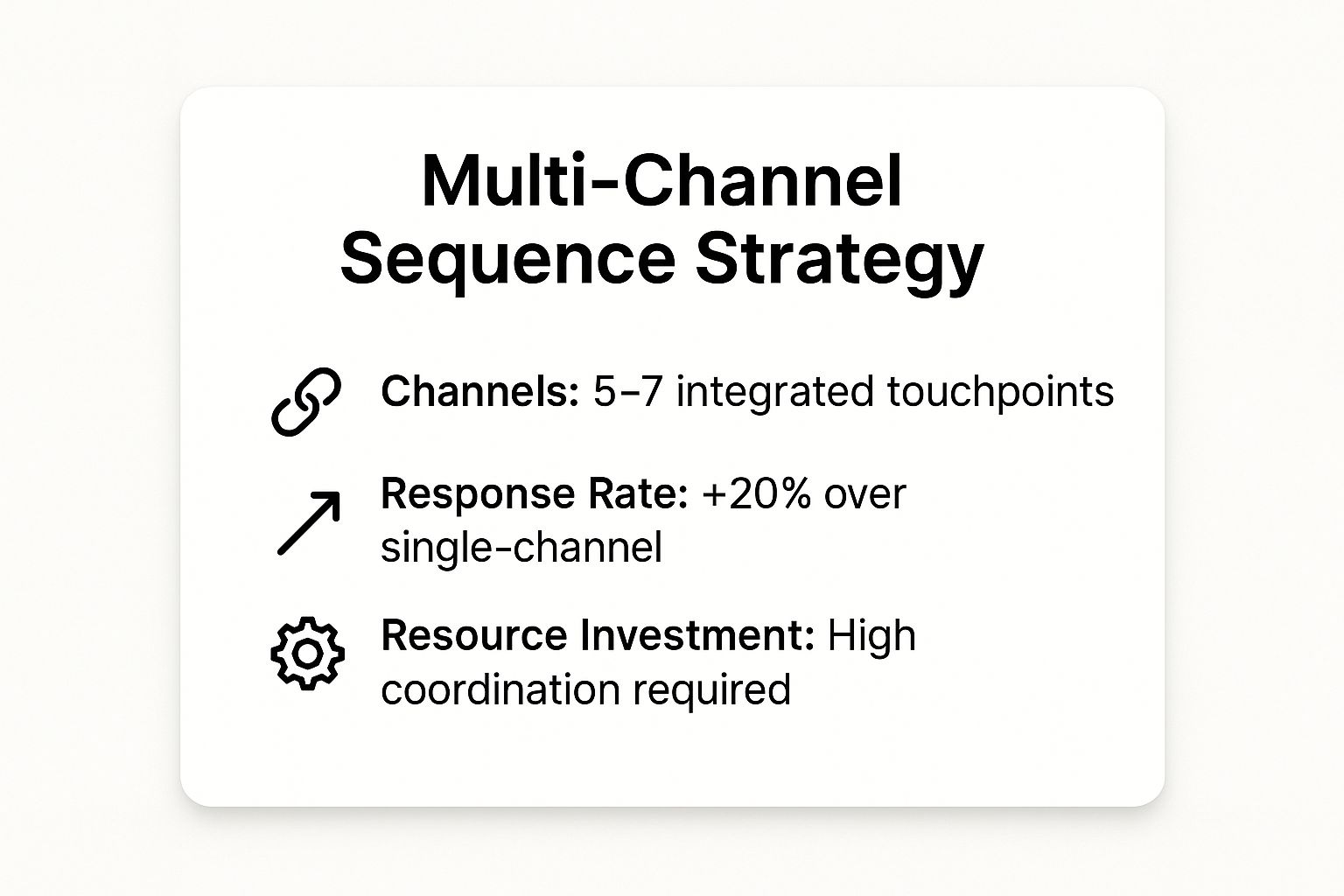Transform Your Sales Outreach with Proven Cadence Strategies
Stop wasting time with ineffective sales outreach. This listicle delivers eight actionable sales cadence best practices designed to transform your approach and boost conversions. Whether you're a freelancer, part of a small sales team, or managing a large enterprise operation, these strategies will provide tangible improvements to your sales process. We'll equip you with the knowledge to build a predictable sales pipeline and close more deals.
This isn't about generic advice. We're diving deep into specific tactics you can implement immediately, including how to:
- Optimize your timing: Discover the optimal frequency and timing for each touchpoint in your sequence.
- Personalize your messaging: Craft impactful messages that resonate with individual prospects based on their behavior and needs.
- Leverage multiple channels: Go beyond email and incorporate diverse channels for a more engaging experience.
- Analyze and refine: Implement data-driven optimization to continuously improve your sales cadence performance.
A well-defined sales cadence is more than just a series of emails; it's a strategic framework for consistent and effective prospect engagement. It helps you stay top-of-mind, nurture leads, and build stronger relationships, ultimately leading to more closed deals and higher revenue. This listicle provides a curated collection of sales cadence best practices that will empower you to achieve just that. We'll cover:
- Multi-Channel Sequence Strategy
- Strategic Timing and Frequency Optimization
- Value-First Messaging Framework
- Prospect Behavior-Based Personalization
- Breakup Email and Re-engagement Tactics
- CRM Integration and Activity Tracking
- A/B Testing and Continuous Optimization
- Sales and Marketing Alignment Framework
Get ready to refine your outreach and maximize your sales potential.
1. Multi-Channel Sequence Strategy
A multi-channel sequence strategy elevates your sales cadence beyond single-channel outreach. It leverages a coordinated mix of communication methods like email, phone calls, social media (LinkedIn, Twitter), text messages, and even personalized video messages. This approach recognizes that different prospects prefer different communication channels. By diversifying your touchpoints, you significantly increase the likelihood of engagement and response. This strategy is a critical element of effective sales cadence best practices.
Examples of Multi-Channel Success
Companies like HubSpot, Salesforce, and Outreach.io have effectively implemented multi-channel sequences. HubSpot, for example, might combine a LinkedIn connection request with a personalized email, followed by a phone call and a video message. Salesforce often employs an omnichannel approach that blends email, social selling, and direct mail. Outreach.io, a leading sales engagement platform, champions multi-step sequences that integrate email, calls, and LinkedIn interactions.
Actionable Tips for Implementation
- Start small and scale: Begin with 2-3 channels and gradually incorporate more as you refine your coordination and messaging.
- Consistent messaging: Maintain consistent messaging themes across all channels, reinforcing your value proposition while tailoring the format to each platform.
- Track and optimize: Monitor which channel combinations yield the highest response rates for different prospect segments.
- Personalize channel selection: Base your channel choices on the prospect's industry, role, and demonstrated communication preferences. For example, a C-level executive might respond better to a direct phone call than a text message.
- Leverage automation: Utilize automation tools to ensure proper timing and sequencing of your multi-channel outreach. This frees up your time for more strategic activities.
The following infographic provides a quick reference for key data points related to the multi-channel sequence strategy. It summarizes the typical number of touchpoints, the potential increase in response rates compared to single-channel outreach, and the resource investment required.

As the infographic illustrates, while implementing a multi-channel sequence requires significant coordination, the potential for increased response rates (+20% over single-channel) makes it a worthwhile investment. This reinforces the importance of strategic planning and resource allocation when adopting this approach.
This video offers further insights into building effective multi-channel sequences.
When and Why to Use this Approach
Multi-channel sequences are particularly effective when dealing with complex sales cycles, high-value prospects, or competitive landscapes. By increasing your touchpoints and personalizing your communication, you nurture stronger relationships and improve your chances of converting prospects into customers. This method deserves its place in the list of best practices because it offers a significant advantage over relying solely on a single channel like email. The benefits include improved engagement, increased response rates, and stronger prospect relationships, all contributing to higher conversion rates and ultimately, increased sales.
2. Strategic Timing and Frequency Optimization
Strategic timing and frequency optimization in sales cadence isn't about bombarding prospects; it's about a systematic approach to determining the optimal intervals between touchpoints and the overall cadence frequency. This is based on factors like prospect behavior, industry standards, and your own accumulated response data. This practice focuses on finding the sweet spot between staying top-of-mind and avoiding prospect fatigue through data-driven timing decisions. This approach is crucial for maximizing engagement and conversions within your sales cadence best practices.
Examples of Strategic Timing Success
Several companies have demonstrated the power of data-driven timing. Gong.io's research, for instance, indicates that Tuesday-Thursday are optimal for email outreach. Reply.io, through its data analysis, often recommends a 1-4-7-14 day sequence pattern for initial follow-ups. Salesforce, recognizing the nuances of various industries, provides industry-specific timing recommendations for different verticals.
Actionable Tips for Implementation
- Start with industry benchmarks then optimize based on your data: Don't reinvent the wheel. Begin with established best practices for your industry, then refine them based on your specific prospect responses.
- Test different time intervals for different prospect segments: What works for one group may not work for another. Segment your prospects and experiment with different timing intervals to find what resonates best.
- Monitor engagement metrics closely during optimization phases: Track open rates, click-through rates, and response rates to gauge the effectiveness of your timing adjustments.
- Consider prospect's time zone and business schedule: Avoid contacting prospects outside of business hours or on weekends. Respect their time and tailor your outreach accordingly.
- Adjust frequency based on deal size and prospect seniority level: High-value deals and senior-level prospects often require a more personalized and less frequent cadence. When implementing a multi-channel sequence strategy, consider tools that can help you automate social media posts. Source: Learn How to Automate Social Media Posts Effortlessly from Postiz.
When and Why to Use this Approach
Strategic timing and frequency optimization are essential for any sales team looking to maximize efficiency and effectiveness. This approach is particularly beneficial in competitive landscapes where standing out from the noise is paramount. Learn more about Strategic Timing and Frequency Optimization. It also proves valuable when dealing with longer sales cycles, as consistent, well-timed touchpoints nurture the prospect relationship without overwhelming them.
This method deserves its place among sales cadence best practices because it directly addresses the issue of prospect fatigue. By optimizing your timing and frequency, you demonstrate respect for the prospect's time, which fosters stronger relationships and increases the likelihood of positive engagement. The benefits include improved response rates, higher conversion rates, and a more streamlined sales process. This results in better resource allocation and a more efficient use of your sales team's time.
3. Value-First Messaging Framework
A value-first messaging framework prioritizes delivering genuine value, insights, or useful information in every sales cadence touchpoint. Instead of focusing solely on product features or sales pitches, this approach builds trust and credibility. It positions the salesperson as a valuable resource and industry expert who understands the prospect's challenges and market context. This framework is a crucial aspect of sales cadence best practices because it fosters stronger relationships and increases the likelihood of engagement.

Examples of Value-First Success
Companies like Drift, Gong.io, and LinkedIn Sales Navigator have successfully implemented value-first messaging. Drift incorporates educational content into their sales sequences, providing prospects with actionable marketing tips. Gong.io shares relevant sales data and benchmarks, offering valuable market insights. LinkedIn Sales Navigator helps sales professionals leverage industry insights to connect with potential customers. These companies exemplify the effectiveness of leading with value in sales communication.
Actionable Tips for Implementation
- Research: Investigate the prospect's industry challenges before crafting messages. This demonstrates a genuine interest in their business needs.
- Share Case Studies: Include relevant case studies from similar companies. Showcasing successful outcomes builds confidence and resonates with prospects.
- Actionable Insights: Offer actionable insights they can implement immediately. Providing practical value strengthens your position as a trusted advisor.
- Industry Trends: Reference recent industry news or trends relevant to their business. Staying up-to-date demonstrates expertise and adds value to your communication.
- Focus on Outcomes: Concentrate on the business outcomes your product/service can deliver rather than just listing features. Prospects are more interested in results than technical specifications.
When and Why to Use this Approach
Value-first messaging is particularly effective in complex sales cycles, competitive markets, and when targeting high-value prospects. Timing is crucial in sales; consider these best time to post on social media insights from EvergreenFeed as you plan your outreach. By prioritizing value, you nurture stronger, more authentic relationships. This approach increases the likelihood of conversions and establishes long-term partnerships.
This method deserves its place among sales cadence best practices due to its numerous benefits. It enhances engagement, builds trust, and positions you as a valuable partner. This leads to increased response rates, shorter sales cycles, and ultimately, higher conversion rates. By focusing on what the prospect needs, you demonstrate that you understand their challenges and are invested in their success – a crucial element in building lasting business relationships. This approach aligns perfectly with the "sales cadence best practices" keyword as it improves the effectiveness and efficiency of the entire sales process.
4. Prospect Behavior-Based Personalization
Prospect behavior-based personalization represents a significant advancement in sales cadence best practices. This strategy goes beyond basic personalization by dynamically adapting your messaging, timing, and overall approach based on real-time prospect behavior and engagement signals. This means tracking email opens, website visits, content downloads, social media activity, and other digital footprints to craft highly relevant and timely follow-up communications. This approach allows sales teams to anticipate prospect needs and deliver a more personalized and engaging experience.

Examples of Behavior-Based Personalization Success
Leading sales platforms like Salesforce, HubSpot, and Outreach.io offer robust features to facilitate behavior-based personalization. Salesforce Einstein, for example, uses AI to provide behavioral insights, allowing sales reps to anticipate prospect needs. HubSpot's platform allows for website tracking and email engagement scoring, enabling targeted follow-up. Outreach.io empowers sales teams to modify sequences based on prospect triggers. LinkedIn Sales Navigator provides social selling signals to inform outreach strategies.
Actionable Tips for Implementation
- Track key engagement indicators: Implement tracking mechanisms early in the sales process to capture valuable data on prospect interactions.
- Create message variations: Develop a library of message variants tailored to different behavior patterns. For instance, a prospect who downloads a case study might receive a follow-up email offering a personalized demo.
- Prioritize with engagement scoring: Use engagement scoring to identify and prioritize high-potential prospects. This ensures that your sales team focuses their efforts on the most engaged leads.
- Combine behavioral and demographic data: Integrate behavioral data with demographic information to gain a comprehensive understanding of your prospects. This allows for more nuanced and effective personalization.
- Train your sales team: Equip your sales team with the skills and knowledge to interpret and act on behavioral signals. This empowers them to deliver highly personalized and engaging interactions. Learn more about prospect behavior-based personalization.
When and Why to Use this Approach
Prospect behavior-based personalization is particularly valuable in complex sales cycles where nurturing and relationship-building are crucial. It's also highly effective in competitive markets where providing a tailored experience can differentiate you from the competition. By responding to prospect actions in a relevant and timely manner, you demonstrate genuine interest and increase the likelihood of conversion. This strategy is a vital component of sales cadence best practices because it moves beyond generic outreach and enables a more personalized and engaging sales experience. The benefits include increased prospect engagement, higher conversion rates, and stronger customer relationships, ultimately contributing to improved sales performance. This approach significantly improves your chances of converting prospects into loyal customers, firmly establishing its place among the best sales cadence practices.
5. Breakup Email and Re-engagement Tactics
A strategic breakup email and re-engagement tactic gracefully concludes unsuccessful sales cadences. Instead of simply ghosting unresponsive prospects, this approach aims to leave the door open for future opportunities. A well-crafted "breakup" email can often generate responses from previously silent prospects, providing valuable feedback or even rekindling interest. Furthermore, systematic re-engagement strategies ensure that prospects who didn't convert initially but might be valuable in the future remain within your sphere of influence. This practice is a key element of effective sales cadence best practices.
Examples of Breakup Email and Re-engagement Success
Several companies and sales trainers have demonstrated the effectiveness of this approach. HubSpot's "Should I Stay or Should I Go" email template provides a lighthearted yet professional way to gauge prospect interest. Salesforce employs quarterly re-engagement campaigns to nurture leads that have gone cold. Reply.io utilizes trigger-based re-activation sequences, automatically reaching out to prospects based on specific actions or inactivity. The popular "This is my last email" approach, championed by various sales trainers, often elicits a final response from otherwise unresponsive prospects.
Actionable Tips for Implementation
- Be genuine and professional: Craft breakup emails that express genuine appreciation for the prospect's time while clearly stating your intention to pause outreach.
- Include a clear call-to-action: Offer alternative ways to stay connected, such as subscribing to your blog or following your company on social media.
- Set up systematic re-engagement touchpoints: Schedule automated re-engagement emails or calls at predetermined intervals (e.g., quarterly, bi-annually).
- Track breakup email response rates: Monitor the effectiveness of your messaging and adjust your approach based on the feedback received.
- Ask for referrals: Use breakup emails as an opportunity to inquire about potential referrals, leveraging the existing relationship even if the prospect isn't a good fit for your product or service.
When and Why to Use this Approach
Breakup emails and re-engagement tactics are particularly valuable in situations where initial outreach attempts haven't yielded positive results. They are also effective for nurturing long-term leads, staying top-of-mind with prospects, and maximizing the potential of your sales pipeline. This approach is a valuable addition to any sales cadence best practices list because it helps maintain positive relationships, gathers valuable feedback, and identifies potential future opportunities.
This method stands out among sales cadence best practices due to its proactive approach to managing unresponsive prospects. Rather than accepting defeat, it uses the "breakup" as a chance to solicit feedback, maintain a connection, and potentially generate referrals. The benefits include increased response rates, valuable insights into prospect needs, and the potential to reignite interest in the future, contributing to a more robust and efficient sales pipeline. This makes it a valuable tactic for any sales professional looking to optimize their outreach efforts and maximize their conversion rates.
6. CRM Integration and Activity Tracking
CRM integration and activity tracking is the bedrock of effective sales cadence best practices. It involves systematically logging all prospect interactions—emails, calls, meetings, social media engagement—within your customer relationship management (CRM) system. This creates a centralized hub of prospect data, providing a 360-degree view of each individual's journey. This comprehensive tracking empowers data-driven decision-making, performance optimization, and seamless handoffs between marketing and sales teams.
Examples of Successful Implementation
Salesforce, a pioneer in CRM, offers comprehensive activity tracking and reporting capabilities. HubSpot's integrated platform provides a unified sales and marketing activity timeline. Pipedrive's visual pipeline incorporates detailed activity logs for each deal. Outreach.io boasts native CRM integrations that automate activity logging, minimizing manual data entry. These examples showcase the power of integrated systems.
Actionable Tips for Implementation
- Ensure proper CRM training: Invest in thorough training for all team members to maximize CRM utilization and data accuracy.
- Automate logging: Set up automated logging wherever possible to reduce manual work and improve data consistency. Learn more about automating sales processes, including CRM integration, at this helpful resource: Learn more about automating sales processes.
- Standardize documentation: Create standardized processes for activity documentation to ensure uniformity and facilitate reporting.
- Regular data cleansing: Regularly review and clean CRM data to maintain accuracy and eliminate duplicate or outdated information.
- Leverage reporting: Use CRM reporting to identify successful patterns, pinpoint bottlenecks, and optimize your sales cadences for peak performance.
When and Why to Use this Approach
CRM integration and activity tracking is essential for any sales team aiming to optimize its cadence. It’s especially beneficial in complex sales cycles, where multiple touchpoints and interactions are common. By centralizing all prospect data, you gain valuable insights into what works, what doesn’t, and where adjustments are needed.
This practice is crucial for implementing sales cadence best practices because it provides the foundation for data-driven decision-making. Benefits include improved sales forecasting, enhanced team collaboration, increased sales productivity, and the ability to personalize interactions at scale. By leveraging the power of CRM integration, you can transform your sales cadence from a series of disconnected actions into a well-oiled machine that drives consistent results.
7. A/B Testing and Continuous Optimization
A/B testing and continuous optimization represent a data-driven approach to refining and improving sales cadence performance. It involves systematically testing different variables within your cadence to identify what resonates best with your target audience. This method moves beyond guesswork and assumptions, relying instead on concrete data to guide your decisions and maximize your results. This makes A/B testing a crucial component of sales cadence best practices.
Examples of A/B Testing Success
Many leading sales engagement platforms offer built-in A/B testing capabilities. Outreach.io, for example, allows users to test different email subject lines, body copy, and call-to-actions within their sequences. Salesforce's Einstein AI can provide data-driven recommendations for optimizing cadence steps based on historical performance. Reply.io facilitates A/B testing for both subject lines and email content, empowering sales teams to fine-tune their messaging. Furthermore, companies like Uber and Airbnb have developed custom testing frameworks to meticulously analyze and optimize their sales cadences.
Actionable Tips for Implementation
- Test one variable at a time: This isolates the impact of each change, providing clear insights into what drives improvement.
- Sufficient sample size: Ensure you have a large enough sample size to achieve statistically significant results. This validates the reliability of your findings.
- Document everything: Keep detailed records of all tests, including the variations tested and the resulting performance data. This creates a valuable knowledge base for future optimization efforts.
- Prioritize high-impact variables: Start by testing elements with the greatest potential impact, such as subject lines and call-to-actions.
- Consistent testing schedule: Establish a regular testing cadence and adhere to it consistently. This ensures ongoing improvement and keeps your sales strategies aligned with evolving market dynamics.
When and Why to Use this Approach
A/B testing is particularly valuable in dynamic sales environments where buyer behavior and market conditions are constantly shifting. It's essential for complex sales cycles where multiple touchpoints are required to nurture leads. Continuous optimization ensures your cadence remains effective and adaptable over time, driving consistent improvements in engagement and conversion rates.
This approach earns its place among sales cadence best practices because it provides a scientific framework for iterative improvement. The benefits include higher open and click-through rates for emails, improved connection rates for calls, and ultimately, increased sales conversions. By continuously analyzing and refining your cadence based on data, you can achieve significantly better results than relying on intuition alone. This data-driven approach ensures that your sales strategies are always aligned with what resonates most effectively with your prospects, maximizing your chances of success.
8. Sales and Marketing Alignment Framework
A sales and marketing alignment framework is a comprehensive approach to unifying sales cadence strategies with marketing campaigns. It connects lead qualification criteria, customer journey mapping, and consistent messaging. This framework ensures seamless lead handoffs and coordinated nurturing efforts. This provides prospects with a cohesive experience from initial awareness to closing, a key element of sales cadence best practices.
Examples of Framework Success
Several companies have successfully implemented sales and marketing alignment frameworks. HubSpot's smarketing (sales + marketing) methodology is a prime example. Salesforce also utilizes an integrated sales and marketing cloud approach. Marketo leverages revenue cycle analytics and sales insight integration. Account-based marketing (ABM) platforms like Demandbase coordinate directly with sales sequences for optimal alignment.
Actionable Tips for Implementation
- Regular Communication: Establish regular meetings between sales and marketing teams to discuss strategies, share insights, and address challenges.
- Shared Definitions: Create shared definitions for lead qualification and scoring. This ensures both teams are working with the same criteria and prioritizing the most promising leads.
- Coordinated Content: Develop coordinated content that supports both marketing nurturing and sales outreach. This reinforces consistent messaging throughout the buyer's journey.
- Shared Reporting: Implement shared reporting dashboards for visibility into the full funnel. This enables both teams to track progress and identify areas for improvement.
- Feedback Loops: Create feedback loops for continuous improvement of the lead handoff process. This ensures a smooth transition and maximizes conversion rates.
When and Why to Use this Approach
A sales and marketing alignment framework is particularly valuable when dealing with long sales cycles, complex products, or multiple decision-makers. It's also beneficial for companies seeking to improve lead quality, shorten sales cycles, and increase revenue. This framework streamlines the entire sales process, reduces friction, and allows both teams to work more effectively.
This framework is essential for optimizing sales cadence because it eliminates the disconnect between marketing's lead generation efforts and sales' outreach strategies. The benefits include improved lead quality, increased conversion rates, shorter sales cycles, and ultimately, greater revenue growth. This approach is a best practice because it creates a synergistic relationship between two critical functions, maximizing their combined impact on business outcomes. It's more than just a tactic; it's a foundational strategy for sustainable sales success.
Sales Cadence Best Practices Comparison
| Strategy / Framework | Implementation Complexity 🔄 | Resource Requirements ⚡ | Expected Outcomes 📊 | Ideal Use Cases 💡 | Key Advantages ⭐ |
|---|---|---|---|---|---|
| Multi-Channel Sequence Strategy | High 🔄🔄🔄 | High ⚡⚡⚡ | +20% response rate, strong brand presence 📊 | Engaging diverse prospect preferences | Higher response rates, multi-touchpoint engagement ⭐ |
| Strategic Timing and Frequency Optimization | Medium 🔄🔄 | Medium ⚡⚡ | Optimized engagement, reduced unsubscribe rates 📊 | Timing-sensitive prospect outreach | Maximizes engagement while avoiding fatigue ⭐ |
| Value-First Messaging Framework | Medium 🔄🔄 | Medium-High ⚡⚡⚡ | Builds trust and credibility, higher engagement 📊 | Trust-building and education-focused cadences | Positions as trusted advisor, reduces objections ⭐ |
| Prospect Behavior-Based Personalization | High 🔄🔄🔄 | High ⚡⚡⚡ | Higher relevance and conversion rates 📊 | Real-time, behavior-driven outreach | Dramatically boosts response and conversion ⭐ |
| Breakup Email and Re-engagement Tactics | Low-Medium 🔄 | Low-Medium ⚡ | Re-engagement and relationship maintenance 📊 | Ending unsuccessful cadences gracefully | Generates late responses, maintains relationships ⭐ |
| CRM Integration and Activity Tracking | High 🔄🔄🔄 | Medium-High ⚡⚡⚡ | Improved visibility, data-driven decisions 📊 | Sales activity tracking and team collaboration | Comprehensive interaction history, analytics ⭐ |
| A/B Testing and Continuous Optimization | Medium 🔄🔄 | Medium ⚡⚡ | Incremental performance improvements 📊 | Data-driven cadence refinement | Eliminates guesswork, finds winning strategies ⭐ |
| Sales and Marketing Alignment Framework | High 🔄🔄🔄 | High ⚡⚡⚡ | Consistent experience, improved conversions 📊 | Integrating sales and marketing efforts | Seamless handoffs, maximized alignment impact ⭐ |
Supercharge Your Sales Performance with Salesloop.io and These Best Practices
Mastering the art of sales cadence optimization is crucial for consistent revenue growth. This article has explored eight key best practices designed to elevate your sales performance and maximize conversions. From leveraging multi-channel sequences to harnessing the power of prospect behavior-based personalization, each tactic plays a critical role in creating a highly effective sales outreach strategy.
Key Takeaways and Actionable Insights
Let's recap the most impactful takeaways:
- Strategic Timing and Frequency: Avoid overwhelming prospects with excessive contact. Instead, optimize your cadence based on their engagement and behavior.
- Value-Driven Messaging: Prioritize delivering genuine value in every interaction. Focus on addressing prospect pain points and offering solutions.
- Personalization Beyond the Basics: Move beyond simple name insertion. Tailor your messaging to resonate with specific prospect needs and interests based on their actions and profile.
- Data-Driven Optimization: Leverage CRM integration and A/B testing to continually refine your approach and identify what resonates best with your target audience.
These strategies work synergistically to create a cohesive and high-performing sales cadence. By implementing them effectively, you can nurture stronger relationships, build trust, and ultimately, close more deals.
Aligning Sales and Marketing for Maximum Impact
For a successful sales strategy, alignment with your broader marketing efforts is essential. Consistent messaging and shared goals between teams amplify your reach and improve conversion rates. For more details on aligning your sales cadence with broader marketing efforts, check out this article on effective social media marketing best practices. Integrating your sales cadence with a strong social media presence creates a powerful, unified approach to reaching your target audience.
From Strategy to Execution: Implementing These Best Practices
Putting these best practices into action requires a structured approach. Start by auditing your existing sales cadence. Identify areas for improvement and prioritize the strategies that align with your specific business objectives. Next, develop a detailed implementation plan, outlining specific steps, timelines, and metrics for tracking progress. Regularly review your results and make adjustments as needed to optimize your approach.
The Power of Automation and Analytics
Implementing these best practices effectively can be challenging without the right tools. Manually managing complex, multi-channel cadences is time-consuming and prone to errors. This is where sales automation platforms like Salesloop.io become invaluable. Salesloop.io streamlines your sales processes, automates repetitive tasks, and provides powerful analytics dashboards to track your performance.
The Future of Sales: Embracing Change and Innovation
The sales landscape is constantly evolving. By embracing these sales cadence best practices and staying informed about emerging trends, you can position yourself and your team for long-term success. Remember, consistent improvement and adaptation are key to thriving in today's dynamic sales environment.
Ready to transform your sales performance and unlock your full potential? Salesloop.io provides the tools and insights you need to implement these best practices and achieve sustainable growth. Explore Salesloop.io today and discover how it can revolutionize your sales outreach: Salesloop.io





